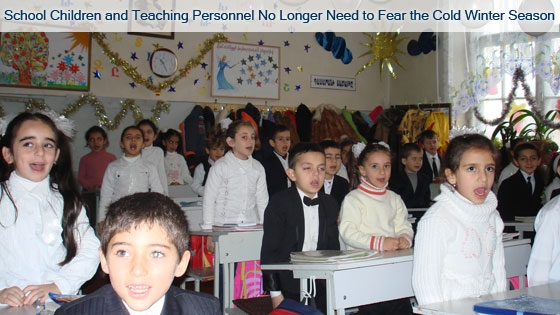Tamara Babayan, Director of the Renewable Energy and Energy Fund, explained that "The program strives to rehabilitate the non–functional heating systems of every school in Armenia, to ‘neutralize‘ the problem in every town."
The implementation of the program started in the Northern (colder) regions of Armenia – Shirak, Aragatsotn, Gegharkounik—and will finish off in the warmer towns of Ararat valley. In the towns of Yeghegnadzor and Vayq of Vayots Dzor Region, the heating problem in every school has been solved.
Gas As a More Cost–Effective Solution
Preliminary results show that schools gain significantly – with savings of 30—50% in heating expenses—from the use of gas–based heating, even when the schools consume significant amounts of it.
The Renewable Energy and Energy Efficiency Fund is currently working to increase the awareness among school principals that by using larger amounts of gas, it will enable them to pay the same as using less since the gas price for large consumers (over 10,000 cubic meters per month) in Armenia is two times lower than for small consumers (less than 10,000 cubic meters).
"Last year we were spending some AMD 900,000 on electricity," said Arusyak Muradyan, Principal of School No. 4 in Ecmiadzin. "For several years we were working only 5 months a year, and the remaining 4—5 months we were paralyzed. We could hardly hold class before running home, resulting in 30 minute classes. Now the children feel like students – this generation is rescued from the cold."
School No. 4 is a changed school – with even a TV in the corridor, and the schoolchildren efficiently using their breaks to get a glimpse of various educational programs. The heating is no longer an issue.
"Our main objective is to improve the quality of education," said Tamara Babayan, Director of the Fund for Renewable Energy and Energy Savings, "and we achieve that through an increased number of class hours and lengthy durations of each class. The forced vacations are being cut off, extra classroom activities are organized, and several groups are established at the school, which significantly improves the educational process. We strive to use cost efficient equipment and devices – the boilers are produced in recent years, and have a high coefficient of useful operations."
Heating Contributes to a Child‘s Education
Since November 2007 it has been warm in School No. 2 of Yeghegnadzor. The temperature in the sun lit classrooms is +20C, and in the gym + 18 C.
Noting the drop in the numbers of missed classes, which is usually witnessed in high school, Principal Anahit Sargsyan said that, "The school is compact–sized and we fit into the allocated funds. The major costs are incurred in the months of January and February. If we compare with electricity costs, we have significant savings, though we use much more gas. The children do not think about the cold anymore."
"It‘s a pity I am graduating already," said Artur Grigoryan, a high school student in Ecmiadzin (Armavir region). "We were waiting for this heat for almost a decade. I am sure younger students will enjoy it as much. It makes it easier to study mathematics, for example, in a warm classroom."
Selection of Schools
The eligibility of urban schools to receive financing is determined based on the availability of gas supplies in the area, the technical state of the school building, and adequacy of engineering design. The selection of schools is based on the cost–effectiveness of investments per student—schools need to fall below a cost effectiveness threshold of US$120 per student to be selected. Due to a significant appreciation of the Armenian dram against the US dollar the Fund decided (and the World Bank agreed) to compute the cost–effectiveness threshold based on a fixed exchange rate used in the PAD.
Currently, due to the cost–effectiveness eligbility, the Government will direct the remaining funding to socially oriented investments, including the rehabilitation of the heating systems of up to ten specialized schools (orphanages, schools for disabled children) located in urban areas outside of Yerevan. The implementing agency is planning to complete the task by the end of 2008.
Important lessons have been learned during the implementation of the school heating component under the UHP, which have been shared with government officials and school principals so as to increase the implementation efficiency and effectiveness of any future investments.
The future looks brighter—and warmer—than ever.


